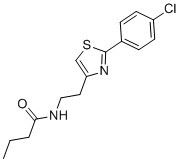Azoramide
This product is for research use only, not for human use. We do not sell to patients.

For small sizes, please check our retail website as below: www.invivochem.com
| Size | Price | Stock |
|---|---|---|
| 250mg | $450 | Check With Us |
| 500mg | $750 | Check With Us |
| 1g | $1125 | Check With Us |
Cat #: V3175 CAS #: 932986-18-0 Purity ≥ 98%
Description: Azoramide is a small-molecule modulator of the unfolded protein response (UPR) and an ER stress alleviator that is reported to have antidiabetic activity.
Top Publications Citing Invivochem Products
Publications Citing InvivoChem Products
Product Promise

- Physicochemical and Storage Information
- Protocol
- Related Biological Data
- Stock Solution Preparation
- Quality Control Documentation
| Molecular Weight (MW) | 308.83 |
|---|---|
| Molecular Formula | C15H17ClN2OS |
| CAS No. | 932986-18-0 |
| Storage | -20℃ for 3 years in powder formr |
| -80℃ for 2 years in solvent | |
| Solubility In Vitro | DMSO: >61 mg/mL (197.5 mM)r |
| Water: < 1 mg/mLr | |
| Ethanol: >61 mg/mL (197.5 mM) | |
| SMILES Code | CCCC(NCCC1=CSC(C2=CC=C(Cl)C=C2)=N1)=O |
| Synonyms | Azoramide |
| Protocol | In Vitro | Azoramide (15 µM; 2-16 h; Huh7 cells) protects cells from induced ER stress. Azoramide counteracts Tunicamycin (Tm, HY-A0098)-induced ATF6LD-Cluc secretion and Tm-induced decrease of ASGR-Cluc secretion. Azoramide suppresses Tm-induced GRP78 and CHOP protein expression. Azoramide (0.01-100 µM; 0-24 h; Huh7 cells) regulates ER folding and secretion capacity without inducing ER stress. Azoramide (15 µM; 2-16 h; Hepa 1-6 cells) alters ER calcium homeostasis and retains a greater fraction of Ca2+ in the ER. |
|---|---|---|
| In Vivo | Azoramide (150 mg/kg; p.o.; daily, for 7 d; Huh7 cells; ob/ob mice) improves glucose homeostasis in mice with genetic obesity and preserves beta cell function and survival during metabolic ER stress. |
These protocols are for reference only. InvivoChem does not
independently validate these methods.
| Solvent volume to be added | Mass (the weight of a compound) | |||
|---|---|---|---|---|
| Mother liquor concentration | 1mg | 5mg | 10mg | 20mg |
| 1mM | 3.2380 mL | 16.1901 mL | 32.3803 mL | 64.7605 mL |
| 5mM | 0.6476 mL | 3.2380 mL | 6.4761 mL | 12.9521 mL |
| 10mM | 0.3238 mL | 1.6190 mL | 3.2380 mL | 6.4761 mL |
| 20mM | 0.1619 mL | 0.8095 mL | 1.6190 mL | 3.2380 mL |
The molarity calculator equation
Mass(g) = Concentration(mol/L) × Volume(L) × Molecular Weight(g/mol)
Mass
=
Concentration
×
Volume
×
Molecular Weight*
The dilution calculator equation
Concentration(start)
×
Volume(start)
=
Concentration(final)
×
Volume(final)
This equation is commonly abbreviated as: C1 V1 = C2 V2
Concentration(start)
C1
×
Volume(start)
V1
=
Concentration(final)
C2
×
Volume(final)
V2
Step One: Enter information below
Dosage mg/kg
Average weight of animals g
Dosing volume per animal µL
Number of animals
Step Two: Enter the in vivo formulation
%DMSO
+
%
+
%Tween 80
+
%ddH2O
Calculation Results:
Working concentration:
mg/ml;
Method for preparing DMSO master liquid:
mg
drug pre-dissolved in
µL
DMSO(Master liquid concentration
mg/mL)
,Please contact us first if the concentration exceeds the DMSO solubility of the batch of drug.
Method for preparing in vivo formulation:
Take
µL
DMSO master liquid, next add
µL
PEG300, mix and clarify, next add
µL
Tween 80,mix and clarify, next add
µL
ddH2O,mix and clarify.
Note:
- (1) Please be sure that the solution is clear before the addition of next solvent. Dissolution methods like vortex, ultrasound or warming and heat may be used to aid dissolving.
- (2) Be sure to add the solvent(s) in order.




































